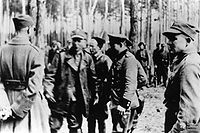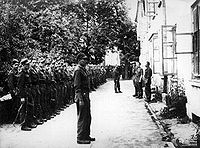
Polish 27th Home Army Infantry Division
Encyclopedia


Poland
Poland , officially the Republic of Poland , is a country in Central Europe bordered by Germany to the west; the Czech Republic and Slovakia to the south; Ukraine, Belarus and Lithuania to the east; and the Baltic Sea and Kaliningrad Oblast, a Russian exclave, to the north...
Armia Krajowa
Armia Krajowa
The Armia Krajowa , or Home Army, was the dominant Polish resistance movement in World War II German-occupied Poland. It was formed in February 1942 from the Związek Walki Zbrojnej . Over the next two years, it absorbed most other Polish underground forces...
unit fighting in 1944 in Volhynia
Volhynia
Volhynia, Volynia, or Volyn is a historic region in western Ukraine located between the rivers Prypiat and Southern Bug River, to the north of Galicia and Podolia; the region is named for the former city of Volyn or Velyn, said to have been located on the Southern Bug River, whose name may come...
region. It was recreated on January 15, 1944 from smaller partisan units of self-defence during the Volhynia massacre
Massacres of Poles in Volhynia
The Massacres of Poles in Volhynia and Eastern Galicia were part of an ethnic cleansing operation carried out by the Ukrainian Insurgent Army West in the Nazi occupied regions of the Eastern Galicia , and UPA North in Volhynia , beginning in March 1943 and lasting until the end of...
and was patterned after the prewar Polish 27th Infantry Division.
History
The unit was mobilized from secondary units from the Kowel, ŁuckLutsk
Lutsk is a city located by the Styr River in northwestern Ukraine. It is the administrative center of the Volyn Oblast and the administrative center of the surrounding Lutskyi Raion within the oblast...
and Równe
Równe
Równe may refer to:*Polish name for Rivne in Ukraine*Równe, Masovian Voivodeship *Równe, Opole Voivodeship *Równe, Pomeranian Voivodeship *Równe, Subcarpathian Voivodeship...
Home Army inspectorates as well as from former Polish police collaborators who had left German service. After mobilization in March 1944, the division became one of the largest partisan unit in Central Europe
Central Europe
Central Europe or alternatively Middle Europe is a region of the European continent lying between the variously defined areas of Eastern and Western Europe...
with 7300 soldiers, officers and NCOs
Non-commissioned officer
A non-commissioned officer , called a sub-officer in some countries, is a military officer who has not been given a commission...
.
The division initially aided local self-defence units during the massacres of Poles in Volhynia
Massacres of Poles in Volhynia
The Massacres of Poles in Volhynia and Eastern Galicia were part of an ethnic cleansing operation carried out by the Ukrainian Insurgent Army West in the Nazi occupied regions of the Eastern Galicia , and UPA North in Volhynia , beginning in March 1943 and lasting until the end of...
and fought against the Ukrainian Insurgent Army. It also fought German anti-partisan units and regular Wehrmacht
Wehrmacht
The Wehrmacht – from , to defend and , the might/power) were the unified armed forces of Nazi Germany from 1935 to 1945. It consisted of the Heer , the Kriegsmarine and the Luftwaffe .-Origin and use of the term:...
troops. Despite orders by the Polish government not to harm civilians, Home Army partisans retaliated against the massacre of Poles by burning down Ukrainian villages and killing ethnic Ukrainians whom they encountered on Volhynian roads. In 1944 the division fought several major battles near Włodzimierz Wołyński
Volodymyr-Volynskyi
Volodymyr-Volynsky is a city located in Volyn Oblast, in north-western Ukraine. Serving as the administrative centre of the Volodymyr-Volynsky District, the city itself is also designated as a separate raion within the oblast...
(February 23), Hołoby (March 9) and Zasmyki (March 17). During the latter two battles the division cooperated with local Soviet
Soviet Union
The Soviet Union , officially the Union of Soviet Socialist Republics , was a constitutionally socialist state that existed in Eurasia between 1922 and 1991....
partisan groups and the advancing Red Army
Red Army
The Workers' and Peasants' Red Army started out as the Soviet Union's revolutionary communist combat groups during the Russian Civil War of 1918-1922. It grew into the national army of the Soviet Union. By the 1930s the Red Army was among the largest armies in history.The "Red Army" name refers to...
. After reaching the frontline and contacting with the Soviets, Col. Jan Kiwerski "Oliwa" was asked to combine the unit with the Red Army as a regular unit of Soviet-backed Polish army. He declined and returned to partisan fighting. The division was surrounded by the Germans near Kowel on April 2.
After receiving a promise of Soviet help, the unit fought surrounded for two weeks. When no help arrived, the united started to break through in the direction of Włodawa. As a result of heavy fighting, it lost between 10% and 50% of personnel.
The division returned northwards and was surrounded by the end of May. Elements of the division broke through the Prypeć river
Pripyat River
The Pripyat River or Prypiat River is a river in Eastern Europe, approximately long. It flows east through Ukraine, Belarus, and Ukraine again, draining into the Dnieper....
and reached the Soviet lines. The officers were arrested by the NKVD
NKVD
The People's Commissariat for Internal Affairs was the public and secret police organization of the Soviet Union that directly executed the rule of power of the Soviets, including political repression, during the era of Joseph Stalin....
and sent to Russia while most of the soldiers were conscripted to the army of Gen. Zygmunt Berling
Zygmunt Berling
Zygmunt Henryk Berling was a Polish general and politician. He fought for the independence of Poland in the early 20th century. During Second World War he was sentenced to death in absentia for desertion from the Polish Army of General Władysław Anders...
.
The remnants of the division withdrew westwards, crossed the Bug River
Bug River
The Bug River is a left tributary of the Narew river flows from central Ukraine to the west, passing along the Ukraine-Polish and Polish-Belarusian border and into Poland, where it empties into the Narew river near Serock. The part between the lake and the Vistula River is sometimes referred to as...
on June 7 to the Parczew
Parczew
Parczew is a town in eastern Poland, with a population of 10,281 . Situated in the Lublin Voivodeship , previously in Biała Podlaska Voivodeship . It is the capital of Parczew County.-History:...
Forest near Lublin
Lublin
Lublin is the ninth largest city in Poland. It is the capital of Lublin Voivodeship with a population of 350,392 . Lublin is also the largest Polish city east of the Vistula river...
. It joined other Home Army units and took part in the liberation of Kock
Kock
Kock is a town in eastern Poland, about 45 km north of Lublin and 120 km south-east of Warsaw. It lies in Lublin Voivodeship, in Lubartów County. It is the capital of the Kock Commune.As of 2004, its population numbered 3,509.-History:...
, Lubartów
Lubartów
Lubartów is a town in eastern Poland, with 23,000 inhabitants , situated in Lublin Voivodeship. It is the capital of Lubartów County and the Lubartów Commune.-History:...
, and the village Firlej on July 21.
After the Red Army reached the area they took over the captured territory. Most of the divisions officers, NCOs and ordinary soldiers were arrested by the NKVD and were interred in GuLag
Gulag
The Gulag was the government agency that administered the main Soviet forced labor camp systems. While the camps housed a wide range of convicts, from petty criminals to political prisoners, large numbers were convicted by simplified procedures, such as NKVD troikas and other instruments of...
s. Only a small part joined the Red Army or the Polish Army.
Commanders

- Col. Kazimierz Damian Bąbiński "Luboń" - January 15 - February 11
- Lt.Col. Jan Wojciech Kiwerski "Oliwa" - February 11 - April 18
- Maj. Jan Szatowski "Kowal" - April 18 - May 3
- Maj. Tadeusz Sztumberk-Rychter "Żegota" - May 3 - July 16
- Col. Jan Kotowicz "Twardy" - July 16 - July 25

